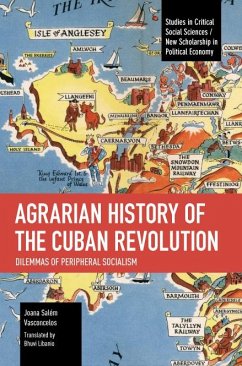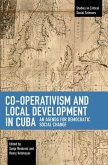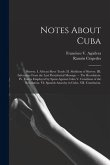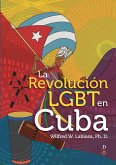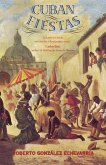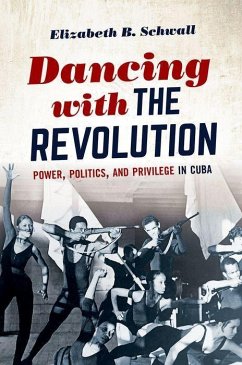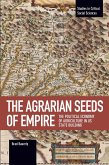Joana Salém VasconcelosDilemmas of Peripheral Socialism
Agrarian History of the Cuban Revolution
Dilemmas of Peripheral Socialism
Übersetzer: Libiano, Bhuvi
Joana Salém VasconcelosDilemmas of Peripheral Socialism
Agrarian History of the Cuban Revolution
Dilemmas of Peripheral Socialism
Übersetzer: Libiano, Bhuvi
- Broschiertes Buch
- Merkliste
- Auf die Merkliste
- Bewerten Bewerten
- Teilen
- Produkt teilen
- Produkterinnerung
- Produkterinnerung
In Agrarian History of the Cuban Revolution, the Brazilian historian Joana Salém Vasconcelos presents in clear language the complicated challenge of overcoming the condition of Latin America's underdevelopment through a revolutionary process. Based on diverse historical sources, she demonstrates why the sugar plantation economic structure in Cuba was not entirely changed by the 1959 Revolution. Vasconcelos narrates in detail the three dimensions of Cuban agrarian transformation during the decisive 1960s - the land tenure system, the crop regime, and the labour regime - and its social and…mehr
Andere Kunden interessierten sich auch für
![Co-Operativism and Local Development in Cuba Co-Operativism and Local Development in Cuba]() Co-Operativism and Local Development in Cuba32,99 €
Co-Operativism and Local Development in Cuba32,99 €![Afro-Cuban Religions Afro-Cuban Religions]() Miguel BarnetAfro-Cuban Religions20,99 €
Miguel BarnetAfro-Cuban Religions20,99 €![Notes About Cuba: Slavery. I. African Slave Trade. II. Abolition of Slavery. III. Inferences From the Last Presidential Message. -- The Notes About Cuba: Slavery. I. African Slave Trade. II. Abolition of Slavery. III. Inferences From the Last Presidential Message. -- The]() Ramón CéspedesNotes About Cuba: Slavery. I. African Slave Trade. II. Abolition of Slavery. III. Inferences From the Last Presidential Message. -- The17,99 €
Ramón CéspedesNotes About Cuba: Slavery. I. African Slave Trade. II. Abolition of Slavery. III. Inferences From the Last Presidential Message. -- The17,99 €![La Revolución LGBT En Cuba (the LGBT Cuban Revolution) La Revolución LGBT En Cuba (the LGBT Cuban Revolution)]() Wilfred W LabiosaLa Revolución LGBT En Cuba (the LGBT Cuban Revolution)21,99 €
Wilfred W LabiosaLa Revolución LGBT En Cuba (the LGBT Cuban Revolution)21,99 €![Cuban Fiestas Cuban Fiestas]() Roberto Gonzalez EchevarriaCuban Fiestas24,99 €
Roberto Gonzalez EchevarriaCuban Fiestas24,99 €![Dancing with the Revolution Dancing with the Revolution]() Elizabeth B SchwallDancing with the Revolution36,99 €
Elizabeth B SchwallDancing with the Revolution36,99 €![The Agrarian Seeds of Empire The Agrarian Seeds of Empire]() Brad BauerlyThe Agrarian Seeds of Empire32,99 €
Brad BauerlyThe Agrarian Seeds of Empire32,99 €-
-
-
In Agrarian History of the Cuban Revolution, the Brazilian historian Joana Salém Vasconcelos presents in clear language the complicated challenge of overcoming the condition of Latin America's underdevelopment through a revolutionary process. Based on diverse historical sources, she demonstrates why the sugar plantation economic structure in Cuba was not entirely changed by the 1959 Revolution. Vasconcelos narrates in detail the three dimensions of Cuban agrarian transformation during the decisive 1960s - the land tenure system, the crop regime, and the labour regime - and its social and political actors. She explains the paths and detours of Cuban agrarian policies, contextualized in a labour-intensive economy that needs desperately to increase productivity and, at the same time, promised widely to emancipate workers from labour exploitation. Cuban agrarian and economic contradictions are well-synthetized with the concept of Peripheral Socialism.
Hinweis: Dieser Artikel kann nur an eine deutsche Lieferadresse ausgeliefert werden.
Hinweis: Dieser Artikel kann nur an eine deutsche Lieferadresse ausgeliefert werden.
Produktdetails
- Produktdetails
- Verlag: Haymarket Books
- Seitenzahl: 332
- Erscheinungstermin: 28. Mai 2024
- Englisch
- Abmessung: 229mm x 152mm x 19mm
- Gewicht: 476g
- ISBN-13: 9798888902332
- Artikelnr.: 69929917
- Herstellerkennzeichnung
- Libri GmbH
- Europaallee 1
- 36244 Bad Hersfeld
- gpsr@libri.de
- Verlag: Haymarket Books
- Seitenzahl: 332
- Erscheinungstermin: 28. Mai 2024
- Englisch
- Abmessung: 229mm x 152mm x 19mm
- Gewicht: 476g
- ISBN-13: 9798888902332
- Artikelnr.: 69929917
- Herstellerkennzeichnung
- Libri GmbH
- Europaallee 1
- 36244 Bad Hersfeld
- gpsr@libri.de
Joana Salém Vasconcelos, has a Ph.D. on Economic History at University of São Paulo and a Master's Degree on Economic Development at State University of Campinas. She is coordinating editor of Latin American Perspectives (US) and associate researcher of Centro de Estudios de Historia Agraria en América Latina (CEHAL).
Acknowledgments
Foreword—English Edition Cuba’s Present and a Specter Haunting the
Spectators
Foreword—Brazilian Edition
List of Tables, Charts, and Maps
Cuban Provinces from 1940 to 1976
Introduction Dilemmas of Peripheral Socialism
1 Modernization of Cuban Plantation (1902–1958)
1 Latifundium-Minifundium Land Tenure Structure
1.1 Between Latifundium and Minifundium
1.2 Origins of Structural Heterogeneity
1.3 Social Actors of Modern Plantation
2 Cropping Regimes: Sugarcane Fields in Wall Street
2.1 Military Order No.62 and Primitive Accumulation
2.2 Dance of the Millions
2.3 Reciprocal Trade Agreement Act of 1934 and the Jones-Costigan Amendment
2.4 Ascension of Cuban Saccharocracy
3 Labor Regime: the Curse of the Crowds
3.1 Statistics Cover-Up
3.2 A Portrait of Rural Misery
3.3 Structural Unemployment and tiempo muerto
4 The World Seen from Above
4.1 Batista and the Rockefeller-Sullivan
4.2 A Portrait of Saccharocracy
5 Revolution against Underdevelopment
5.1 The Moncada Program
5.2 Revolutionary Democratic Nationalism
5.3 Sierra Maestra Law No.3
2 First Agrarian Reform, Impulses and Impasses (1958–1963)
1 Transformation of the Land Tenure System
1.1 The Agrarian Reform Law of 1959
1.2 Nationalization Laws
1.3 A Portrait of Structural Transformation
2 Cooperatives or State Farms?
2.1 The Proletarian Peasant and the Scale Preservation
2.2 Agricultural Cooperatives
2.3 Granjas del Pueblo (People’s Farm)
2.4 Converting Cooperatives into Granjas
3 Peasantry: Principle of Voluntarism and anap
3.1 anap Foundation and Its Principles
3.2 Mistakes Made with the Peasantry
3.3 anap ’s “Administrativism”
3.4 Politics of Voluntary Collectivism
4 Agricultural Diversification: Disruption of the Double Articulation
4.1 Neocolonial Insertion Crisis: the Search for National Sovereignty
4.2 Increase of Internal Demand: Searching for Social Equity
4.3 Diversification: Searching for Economic Development
4.4 Structural Problems of Diversification: Extensive, Disorganized, and
Inefficient
4.5 Intensification of Class Struggle and General Economic Trends in 1963
3 Second Agrarian Reform and the Sugar Paradox (1963–1967)
1 Transformation of the Land Tenure System
1.1 The Agrarian Reform Law of October 1963
1.2 Cyclone Flora
1.3 The Social Structure of the New Agriculture
1.4 A Combined Strategy: Sugar, Diversification and Technology
2 The Soviet Union and the Sugar Paradox
2.1 The 1964 Agreement
2.2 Back to Sugar
2.3 Inserted Revolution and the Paradox of the New Dependency
2.4 Third World: Arena for National Sovereignty
3 Agrarian Management: between Relative Autonomy and Centralization
3.1 Agrupamientos, Departamentos, Lotes (Grouping, Departments, Allotments)
3.2 Aspects of the Great Debate in Agriculture
4 Specialized Diversification and Technology-Intensive Model
4.1 Crop Performance between 1964 and 1970
4.2 Combinados and Special Plans: Modes of Diversification
4.3 Peasantry and Special Plans
5 Technological Dependency and Sugarcane Mechanization
5.1 Investment and Consumption
5.2 Tiempo Muerto in Reverse: Unemployment in Disguise
5.3 Paths and Detours of Technological Choice
4 The 1970 Harvest and Development Strategy (1967–1970)
1 Agrarian Structure and Development Strategy
1.1 Import Substituting Industrialization
1.2 Turnpike Strategy: the Return of “Comparative Advantages”?
1.3 Why Ten Million?
2 Revolutionary Offensive and Moral Economy
2.1 Moral Economy and Ideological Centralization
2.2 Collective Wage Agreement and Lack of Accounting Control
2.3 The Shrinking of the Peasantry
3 The 1970 Harvest: Plan and Reality
3.1 Simultaneous Battles
3.2 The Harvest in Numbers
3.3 Causes of Failure
3.4 Structural Distortions
4 Voluntary Work: between Consciousness and Coercion
4.1 Drop in Productivity and Elimination of the Foreman
4.2 Criticism of Volunteer Labor
4.3 The Militarization of Labor
4.4 Self-Criticism
5 Conclusion Dilemmas of Peripheral Socialism
1 Geopolitical Implications: the Source of Surplus
1.1 The Transfer of Soviet Resource
1.2 Multilateral Payment Agreement
1.3 Cold War and Geopolitical Advantages
1.4 Joining the comecon
2 Peripheral Socialism and Rationality of the Possible
2.1 From Segregation to Egalitarianism
2.2 Development of the Productive Forces
2.3 Peripheral Socialism and Rationality of the Possible
Bibliography
Index
Foreword—English Edition Cuba’s Present and a Specter Haunting the
Spectators
Foreword—Brazilian Edition
List of Tables, Charts, and Maps
Cuban Provinces from 1940 to 1976
Introduction Dilemmas of Peripheral Socialism
1 Modernization of Cuban Plantation (1902–1958)
1 Latifundium-Minifundium Land Tenure Structure
1.1 Between Latifundium and Minifundium
1.2 Origins of Structural Heterogeneity
1.3 Social Actors of Modern Plantation
2 Cropping Regimes: Sugarcane Fields in Wall Street
2.1 Military Order No.62 and Primitive Accumulation
2.2 Dance of the Millions
2.3 Reciprocal Trade Agreement Act of 1934 and the Jones-Costigan Amendment
2.4 Ascension of Cuban Saccharocracy
3 Labor Regime: the Curse of the Crowds
3.1 Statistics Cover-Up
3.2 A Portrait of Rural Misery
3.3 Structural Unemployment and tiempo muerto
4 The World Seen from Above
4.1 Batista and the Rockefeller-Sullivan
4.2 A Portrait of Saccharocracy
5 Revolution against Underdevelopment
5.1 The Moncada Program
5.2 Revolutionary Democratic Nationalism
5.3 Sierra Maestra Law No.3
2 First Agrarian Reform, Impulses and Impasses (1958–1963)
1 Transformation of the Land Tenure System
1.1 The Agrarian Reform Law of 1959
1.2 Nationalization Laws
1.3 A Portrait of Structural Transformation
2 Cooperatives or State Farms?
2.1 The Proletarian Peasant and the Scale Preservation
2.2 Agricultural Cooperatives
2.3 Granjas del Pueblo (People’s Farm)
2.4 Converting Cooperatives into Granjas
3 Peasantry: Principle of Voluntarism and anap
3.1 anap Foundation and Its Principles
3.2 Mistakes Made with the Peasantry
3.3 anap ’s “Administrativism”
3.4 Politics of Voluntary Collectivism
4 Agricultural Diversification: Disruption of the Double Articulation
4.1 Neocolonial Insertion Crisis: the Search for National Sovereignty
4.2 Increase of Internal Demand: Searching for Social Equity
4.3 Diversification: Searching for Economic Development
4.4 Structural Problems of Diversification: Extensive, Disorganized, and
Inefficient
4.5 Intensification of Class Struggle and General Economic Trends in 1963
3 Second Agrarian Reform and the Sugar Paradox (1963–1967)
1 Transformation of the Land Tenure System
1.1 The Agrarian Reform Law of October 1963
1.2 Cyclone Flora
1.3 The Social Structure of the New Agriculture
1.4 A Combined Strategy: Sugar, Diversification and Technology
2 The Soviet Union and the Sugar Paradox
2.1 The 1964 Agreement
2.2 Back to Sugar
2.3 Inserted Revolution and the Paradox of the New Dependency
2.4 Third World: Arena for National Sovereignty
3 Agrarian Management: between Relative Autonomy and Centralization
3.1 Agrupamientos, Departamentos, Lotes (Grouping, Departments, Allotments)
3.2 Aspects of the Great Debate in Agriculture
4 Specialized Diversification and Technology-Intensive Model
4.1 Crop Performance between 1964 and 1970
4.2 Combinados and Special Plans: Modes of Diversification
4.3 Peasantry and Special Plans
5 Technological Dependency and Sugarcane Mechanization
5.1 Investment and Consumption
5.2 Tiempo Muerto in Reverse: Unemployment in Disguise
5.3 Paths and Detours of Technological Choice
4 The 1970 Harvest and Development Strategy (1967–1970)
1 Agrarian Structure and Development Strategy
1.1 Import Substituting Industrialization
1.2 Turnpike Strategy: the Return of “Comparative Advantages”?
1.3 Why Ten Million?
2 Revolutionary Offensive and Moral Economy
2.1 Moral Economy and Ideological Centralization
2.2 Collective Wage Agreement and Lack of Accounting Control
2.3 The Shrinking of the Peasantry
3 The 1970 Harvest: Plan and Reality
3.1 Simultaneous Battles
3.2 The Harvest in Numbers
3.3 Causes of Failure
3.4 Structural Distortions
4 Voluntary Work: between Consciousness and Coercion
4.1 Drop in Productivity and Elimination of the Foreman
4.2 Criticism of Volunteer Labor
4.3 The Militarization of Labor
4.4 Self-Criticism
5 Conclusion Dilemmas of Peripheral Socialism
1 Geopolitical Implications: the Source of Surplus
1.1 The Transfer of Soviet Resource
1.2 Multilateral Payment Agreement
1.3 Cold War and Geopolitical Advantages
1.4 Joining the comecon
2 Peripheral Socialism and Rationality of the Possible
2.1 From Segregation to Egalitarianism
2.2 Development of the Productive Forces
2.3 Peripheral Socialism and Rationality of the Possible
Bibliography
Index
Acknowledgments
Foreword—English Edition Cuba’s Present and a Specter Haunting the
Spectators
Foreword—Brazilian Edition
List of Tables, Charts, and Maps
Cuban Provinces from 1940 to 1976
Introduction Dilemmas of Peripheral Socialism
1 Modernization of Cuban Plantation (1902–1958)
1 Latifundium-Minifundium Land Tenure Structure
1.1 Between Latifundium and Minifundium
1.2 Origins of Structural Heterogeneity
1.3 Social Actors of Modern Plantation
2 Cropping Regimes: Sugarcane Fields in Wall Street
2.1 Military Order No.62 and Primitive Accumulation
2.2 Dance of the Millions
2.3 Reciprocal Trade Agreement Act of 1934 and the Jones-Costigan Amendment
2.4 Ascension of Cuban Saccharocracy
3 Labor Regime: the Curse of the Crowds
3.1 Statistics Cover-Up
3.2 A Portrait of Rural Misery
3.3 Structural Unemployment and tiempo muerto
4 The World Seen from Above
4.1 Batista and the Rockefeller-Sullivan
4.2 A Portrait of Saccharocracy
5 Revolution against Underdevelopment
5.1 The Moncada Program
5.2 Revolutionary Democratic Nationalism
5.3 Sierra Maestra Law No.3
2 First Agrarian Reform, Impulses and Impasses (1958–1963)
1 Transformation of the Land Tenure System
1.1 The Agrarian Reform Law of 1959
1.2 Nationalization Laws
1.3 A Portrait of Structural Transformation
2 Cooperatives or State Farms?
2.1 The Proletarian Peasant and the Scale Preservation
2.2 Agricultural Cooperatives
2.3 Granjas del Pueblo (People’s Farm)
2.4 Converting Cooperatives into Granjas
3 Peasantry: Principle of Voluntarism and anap
3.1 anap Foundation and Its Principles
3.2 Mistakes Made with the Peasantry
3.3 anap ’s “Administrativism”
3.4 Politics of Voluntary Collectivism
4 Agricultural Diversification: Disruption of the Double Articulation
4.1 Neocolonial Insertion Crisis: the Search for National Sovereignty
4.2 Increase of Internal Demand: Searching for Social Equity
4.3 Diversification: Searching for Economic Development
4.4 Structural Problems of Diversification: Extensive, Disorganized, and
Inefficient
4.5 Intensification of Class Struggle and General Economic Trends in 1963
3 Second Agrarian Reform and the Sugar Paradox (1963–1967)
1 Transformation of the Land Tenure System
1.1 The Agrarian Reform Law of October 1963
1.2 Cyclone Flora
1.3 The Social Structure of the New Agriculture
1.4 A Combined Strategy: Sugar, Diversification and Technology
2 The Soviet Union and the Sugar Paradox
2.1 The 1964 Agreement
2.2 Back to Sugar
2.3 Inserted Revolution and the Paradox of the New Dependency
2.4 Third World: Arena for National Sovereignty
3 Agrarian Management: between Relative Autonomy and Centralization
3.1 Agrupamientos, Departamentos, Lotes (Grouping, Departments, Allotments)
3.2 Aspects of the Great Debate in Agriculture
4 Specialized Diversification and Technology-Intensive Model
4.1 Crop Performance between 1964 and 1970
4.2 Combinados and Special Plans: Modes of Diversification
4.3 Peasantry and Special Plans
5 Technological Dependency and Sugarcane Mechanization
5.1 Investment and Consumption
5.2 Tiempo Muerto in Reverse: Unemployment in Disguise
5.3 Paths and Detours of Technological Choice
4 The 1970 Harvest and Development Strategy (1967–1970)
1 Agrarian Structure and Development Strategy
1.1 Import Substituting Industrialization
1.2 Turnpike Strategy: the Return of “Comparative Advantages”?
1.3 Why Ten Million?
2 Revolutionary Offensive and Moral Economy
2.1 Moral Economy and Ideological Centralization
2.2 Collective Wage Agreement and Lack of Accounting Control
2.3 The Shrinking of the Peasantry
3 The 1970 Harvest: Plan and Reality
3.1 Simultaneous Battles
3.2 The Harvest in Numbers
3.3 Causes of Failure
3.4 Structural Distortions
4 Voluntary Work: between Consciousness and Coercion
4.1 Drop in Productivity and Elimination of the Foreman
4.2 Criticism of Volunteer Labor
4.3 The Militarization of Labor
4.4 Self-Criticism
5 Conclusion Dilemmas of Peripheral Socialism
1 Geopolitical Implications: the Source of Surplus
1.1 The Transfer of Soviet Resource
1.2 Multilateral Payment Agreement
1.3 Cold War and Geopolitical Advantages
1.4 Joining the comecon
2 Peripheral Socialism and Rationality of the Possible
2.1 From Segregation to Egalitarianism
2.2 Development of the Productive Forces
2.3 Peripheral Socialism and Rationality of the Possible
Bibliography
Index
Foreword—English Edition Cuba’s Present and a Specter Haunting the
Spectators
Foreword—Brazilian Edition
List of Tables, Charts, and Maps
Cuban Provinces from 1940 to 1976
Introduction Dilemmas of Peripheral Socialism
1 Modernization of Cuban Plantation (1902–1958)
1 Latifundium-Minifundium Land Tenure Structure
1.1 Between Latifundium and Minifundium
1.2 Origins of Structural Heterogeneity
1.3 Social Actors of Modern Plantation
2 Cropping Regimes: Sugarcane Fields in Wall Street
2.1 Military Order No.62 and Primitive Accumulation
2.2 Dance of the Millions
2.3 Reciprocal Trade Agreement Act of 1934 and the Jones-Costigan Amendment
2.4 Ascension of Cuban Saccharocracy
3 Labor Regime: the Curse of the Crowds
3.1 Statistics Cover-Up
3.2 A Portrait of Rural Misery
3.3 Structural Unemployment and tiempo muerto
4 The World Seen from Above
4.1 Batista and the Rockefeller-Sullivan
4.2 A Portrait of Saccharocracy
5 Revolution against Underdevelopment
5.1 The Moncada Program
5.2 Revolutionary Democratic Nationalism
5.3 Sierra Maestra Law No.3
2 First Agrarian Reform, Impulses and Impasses (1958–1963)
1 Transformation of the Land Tenure System
1.1 The Agrarian Reform Law of 1959
1.2 Nationalization Laws
1.3 A Portrait of Structural Transformation
2 Cooperatives or State Farms?
2.1 The Proletarian Peasant and the Scale Preservation
2.2 Agricultural Cooperatives
2.3 Granjas del Pueblo (People’s Farm)
2.4 Converting Cooperatives into Granjas
3 Peasantry: Principle of Voluntarism and anap
3.1 anap Foundation and Its Principles
3.2 Mistakes Made with the Peasantry
3.3 anap ’s “Administrativism”
3.4 Politics of Voluntary Collectivism
4 Agricultural Diversification: Disruption of the Double Articulation
4.1 Neocolonial Insertion Crisis: the Search for National Sovereignty
4.2 Increase of Internal Demand: Searching for Social Equity
4.3 Diversification: Searching for Economic Development
4.4 Structural Problems of Diversification: Extensive, Disorganized, and
Inefficient
4.5 Intensification of Class Struggle and General Economic Trends in 1963
3 Second Agrarian Reform and the Sugar Paradox (1963–1967)
1 Transformation of the Land Tenure System
1.1 The Agrarian Reform Law of October 1963
1.2 Cyclone Flora
1.3 The Social Structure of the New Agriculture
1.4 A Combined Strategy: Sugar, Diversification and Technology
2 The Soviet Union and the Sugar Paradox
2.1 The 1964 Agreement
2.2 Back to Sugar
2.3 Inserted Revolution and the Paradox of the New Dependency
2.4 Third World: Arena for National Sovereignty
3 Agrarian Management: between Relative Autonomy and Centralization
3.1 Agrupamientos, Departamentos, Lotes (Grouping, Departments, Allotments)
3.2 Aspects of the Great Debate in Agriculture
4 Specialized Diversification and Technology-Intensive Model
4.1 Crop Performance between 1964 and 1970
4.2 Combinados and Special Plans: Modes of Diversification
4.3 Peasantry and Special Plans
5 Technological Dependency and Sugarcane Mechanization
5.1 Investment and Consumption
5.2 Tiempo Muerto in Reverse: Unemployment in Disguise
5.3 Paths and Detours of Technological Choice
4 The 1970 Harvest and Development Strategy (1967–1970)
1 Agrarian Structure and Development Strategy
1.1 Import Substituting Industrialization
1.2 Turnpike Strategy: the Return of “Comparative Advantages”?
1.3 Why Ten Million?
2 Revolutionary Offensive and Moral Economy
2.1 Moral Economy and Ideological Centralization
2.2 Collective Wage Agreement and Lack of Accounting Control
2.3 The Shrinking of the Peasantry
3 The 1970 Harvest: Plan and Reality
3.1 Simultaneous Battles
3.2 The Harvest in Numbers
3.3 Causes of Failure
3.4 Structural Distortions
4 Voluntary Work: between Consciousness and Coercion
4.1 Drop in Productivity and Elimination of the Foreman
4.2 Criticism of Volunteer Labor
4.3 The Militarization of Labor
4.4 Self-Criticism
5 Conclusion Dilemmas of Peripheral Socialism
1 Geopolitical Implications: the Source of Surplus
1.1 The Transfer of Soviet Resource
1.2 Multilateral Payment Agreement
1.3 Cold War and Geopolitical Advantages
1.4 Joining the comecon
2 Peripheral Socialism and Rationality of the Possible
2.1 From Segregation to Egalitarianism
2.2 Development of the Productive Forces
2.3 Peripheral Socialism and Rationality of the Possible
Bibliography
Index

